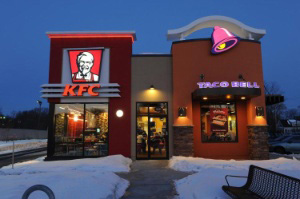Jun 23 2009
Yum! Brands, Inc. (NYSE: YUM), the world’s largest restaurant company and parent of Taco Bell, Pizza Hut, KFC, has constructed the Company’s first building under the United States Green Building Council’s LEED® (Leadership in Energy and Environmental Design) program. Yum! Brands’ KFC-Taco Bell restaurant in Northampton, Massachusetts has been awarded LEED Gold certification.

Developed through the collaboration of architects, contractors, engineers, environmental groups, government agencies and more, LEED is a nationally accepted and independent system to measure environmental performance of buildings. LEED certification is determined by the United States Green Building Council (USGBC).
Buildings granted LEED certification are recognized for their environmental commitment in the areas of sustainable sites, water efficiency, energy and atmosphere, materials and resources, indoor environmental quality and innovation in design.
With the assistance of some of the leading sustainability and restaurant experts, Yum! Brands opened the KFC-Taco Bell restaurant in Northampton in December of 2008 as part of the Company’s on-going commitment to corporate social responsibility. The restaurant marks Yum’s first building constructed under the United States Green Building Council’s LEED program.
“We’re thrilled that the Northampton KFC-Taco Bell has been granted LEED Gold certification,” said Jonathan Balas, AIA, LEED AP, KFC Project Architect, the architect who spearheaded and coordinated the project. “The certification fuels our passion and commitment to researching green building solutions and sets an example of what is possible for the restaurant industry. This building is our first step in this important effort.”
“KFC-Taco Bell’s LEED certification demonstrates tremendous green building leadership,” said Rick Fedrizzi, President, CEO & Founding Chair, U.S. Green Building Council. “The urgency of USGBC’s mission has challenged the industry to move faster and reach further than ever before, and KFC-Taco Bell serves as a prime example with just how much we can accomplish.”
The restaurant provides a testing lab to study the performance of green technologies and approaches to reduce the Company’s environmental impact. The design at the LEED certified KFC-Taco Bell is categorized by several key aspects including reducing carbon footprint, water conservation and quality, and sensible material use. The restaurant is designed to use 30 percent less energy and water than a conventional building, cut CO2 emissions, reduce waste going to landfills/incinerators and educating visitors and employees on sustainable design.
In order to reduce its carbon footprint, the restaurant uses solar energy to preheat fresh air coming into the building which reduces the use of natural gas. Additionally, the restaurant is using a sophisticated lighting control system that maximizes the use of natural light. LED lights, the most energy-efficient available today, were utilized where feasible both inside the restaurant, in the parking lot and on signage. Utilizing more energy efficient kitchen and building equipment, and purchasing renewable energy credits, also minimizes the restaurant’s carbon footprint.
Water conservation is a high priority at the restaurant. Harvested rainwater is used for irrigation. Fixtures with lower water consumption rates, and a rain garden with filters that improve storm water quality, are in place to address conservation and water use.
Many of the materials used to build the green restaurant, such as counter tops and building insulation, contained recycled content. The wood used during construction was sustainably harvested. The restaurant composts and recycles waste, including enhanced cooking oil reclamation. The building also reduces the environmental impact of new construction and provides a testing “lab” to confirm the feasibility and green performance of new technologies.
In March, 2009, Yum! Brands was named one of the “100 Best Corporate Citizens” by Corporate Responsibility Officer magazine, for its ongoing commitment to corporate responsibility. Corporate Responsibility Officer magazine reviewed the largest publicly traded companies in the U.S. to produce its tenth annual list. The Magazine evaluated publicly accessible documents and determined leaders in seven categories including: environment; climate change; human rights; philanthropy; employee relations; finance; and governance, with environment and employee relations weighted the highest.
Yum! Brands issued its first Corporate Responsibility Report titled “Serving the World” during the fourth quarter of 2008. The Report examines Yum! Brands' social, environmental and economic impact based on company and external stakeholder expectations, with focus on: Corporate Governance and Ethics, Public Policy and Government Affairs, Culture and People Development, Health and Nutrition, Environment, Supply Chain, and Community Giving and can be accessed on www.yum.com/responsibility/.